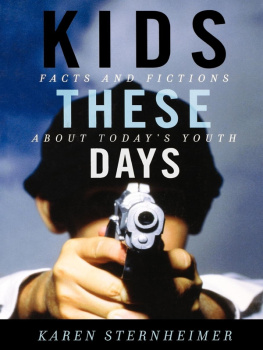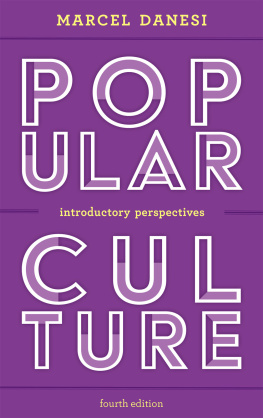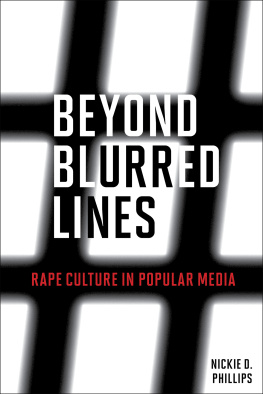
Pop Culture Panics
Moral panics reveal much about a societys social structure and the sociology embedded in everyday life. Th is short text examines extreme reactions to American popular culture over the past century, including crusades against comic books, music, and pinball machines, to help convey the sociological imagination to undergraduates. Sternheimer creates a critical lens through which to view current and future attempts of modern-day moral crusaders, who try to convince us that simple solutionslike regulating popular cultureare the answer to complex social problems. Pop Culture Panics is ideal for use in undergraduate social problems, social deviance, and popular culture courses.
Karen Sternheimer is a sociologist at the University of Southern California, where she is a distinguished fellow at the USC Center for Excellence in Teaching. She is also the author of Connecting Popular Culture and Social Problems: Why Media is Not the Answer (2013), Celebrity Culture and the American Dream: Stardom and Social Mobility (2011), Kids Th ese Days: Facts and Fictions About Todays Youth (2006), Its Not the Media: The Truth About Pop Cultures Influence on Children (2003), and is the editor and lead writer for everydaysociologyblog.com. She has provided commentary for NPR, CNN, MSNBC, the History Channel, and Fox News.
First published 2015
by Routledge
711 Third Avenue, New York, NY 10017
and by Routledge
2 Park Square, Milton Park, Abingdon, Oxon, OX14 4RN
Routledge is an imprint of the Taylor & Francis Group, an informa business
2015 Taylor & Francis
The right of Karen Sternheimer to be identified as author of this work has been asserted by her in accordance with sections 77 and 78 of the Copyright, Designs and Patents Act 1988.
All rights reserved. No part of this book may be reprinted or reproduced or utilized in any form or by any electronic, mechanical, or other means, now known or hereafter invented, including photocopying and recording, or in any information storage or retrieval system, without permission in writing from the publishers.
Trademark notice: Product or corporate names may be trademarks or registered trademarks, and are used only for identification and explanation without intent to infringe.
Library of Congress Cataloging-in-Publication Data
Sternheimer, Karen.
Pop culture panics: how moral crusaders construct meanings of deviance
and delinquency /by Karen Sternheimer.
pages cm
Includes bibliographical references and index.
1. Moral panicsUnited StatesHistory. 2. Popular cultureUnited
States. 3. United StatesMoral conditions. I. Title.
HN90.M6S74 2015
302.17dc23
2014024680
ISBN: 978-0-415-74805-6 (hbk)
ISBN: 978-0-415-74806-3 (pbk)
ISBN: 978-1-315-79670-3 (ebk)
Typeset in Adobe Caslon
by ApexCovantage, LLC
Contents
Fears that video games would cause violence in the 1990s provide a framework in understanding moral panics, moral crusades, for how people actively use fears of popular culture to create new meanings of deviance and delinquency.
The popularity of the movies in the early twentieth century led to moral crusades to regulate content. Immigration, urbanization, and shifting experiences of childhood caused the crusades.
Concerns about gambling and organized crime were projected onto young people during the Great Depression and World War II. Moral crusades against pinball highlight anxieties about working-class spaces and about leisure overtaking the value of hard work.
Postwar fears of delinquency and youth violence reach a fever pitch, which moral crusaders blamed on graphic comic books.
Much of American popular music derives from African Americans. The widespread success of genres such as jazz, rock and roll, and rap created fears of racial integration. As musicians became revered, religious leaders feared that they would lead young people away from traditional religion.
The growth of social media not only produces fear about a new form of communication, but has created new ways to mount moral crusades.
Can you imagine a place where police censor movies, where books are banned and burned, and authorities outlaw pinball machines?
All of these happened in the United States during the twentieth century. But why?
Pop Culture Panics examines these and other extreme reactions to popular culture over the past century. Rather than simply reactions to troubling content, crusades against video games, movies, pinball machines, comic books, music, and new media are rooted in struggles for power over a group feared as a threat to the status quo.
Campaigns against popular culture remind us that people actively work to construct meanings of deviance, as moral crusaders strive to convince others to see the world as they do, and try to encourage us to further restrict the content of popular culture to protect us from them. Anti-pop culture crusades happen when a group is considered both potentially vulnerable to the influence of media and threatening at the same time. Crusaders successfully used anxieties about social change and the increased leisure time of children and teens to create fear and expand the definition of delinquency.
Using examples from recent history offers readers a critical distance from the emotion of moral crusades. The purpose of this book is to create a critical lens through which to view current and future attempts of modern-day moral crusaders, who try to convince us that simple solutionslike regulating popular cultureare the answer to complex social problems.
Learning From Pop Culture Panics
Pop Culture Panics focuses specifically on moral crusaders to better understand what motivated them to wage campaigns against popular culture. In most cases, moral crusaders feel threatened by social changes they connect with a new form of popular culture.
The context and timing are crucial for understanding why people launched crusades against silent movies, pinball machines, comic books, jazz, rock and roll, rap, and video games. Pop Culture Panics explores how fears of immigration, urbanization, anti-Semitism and the reduction of child labor sparked concerns about movies almost as soon as they became popular in the first decade of the twentieth century.
Pinball machines may now seem innocuousand sources of nostalgiabut when they first appeared in the 1930s they coincided with the rise in organized crime and concerns that young people would gamble rather than work.
Comic books aroused postwar anxieties about the new experiences of childhood. Mostly out of the paid labor force with more leisure time and discretionary spending money than ever before, the new favored pastime of idle children awakened fears that juvenile delinquency would skyrocket, with their graphic crime stories and macabre themes.
As postwar children became teens, many began listening to a new genre, rock and roll, a hybrid of many musical traditions largely created by African American musicians. Coinciding with the civil rights movement and challenges to Jim Crow laws, crusades about early rock and roll were rooted in concerns about racial integration. As music became an integral part of baby boomers experiences of adolescence, some religious leaders feared that rock was displacing the role of traditional religion in young peoples lives, and that the music itself was a satanic force. Moral crusaders claimed that hidden satanic messages could be heard on some records when played backwards, and called for legislation to create labels and warn parents of the alleged threat.









